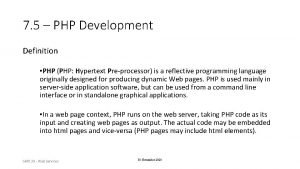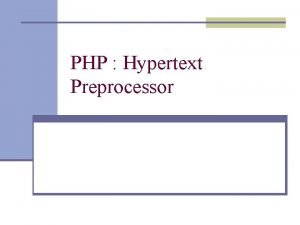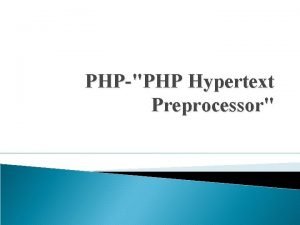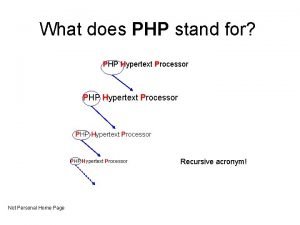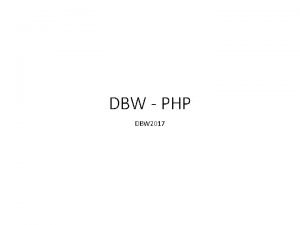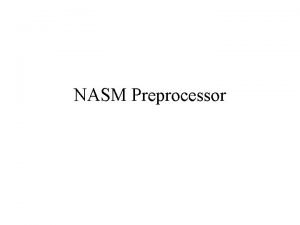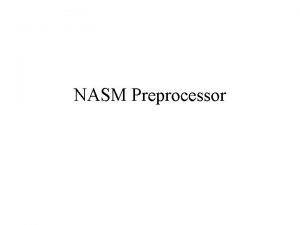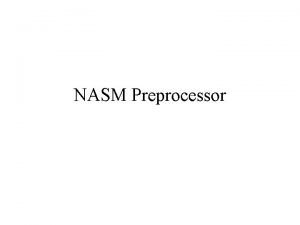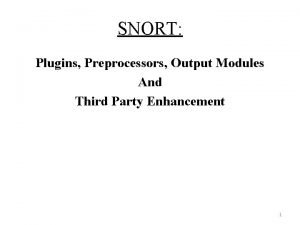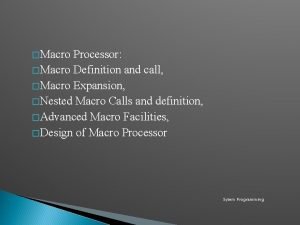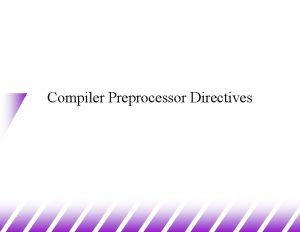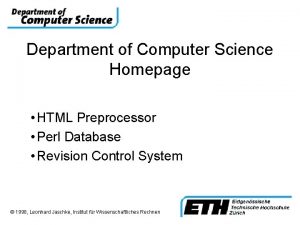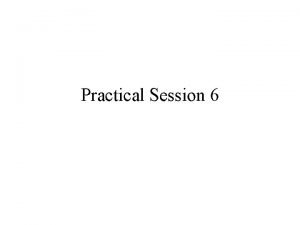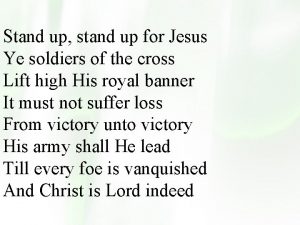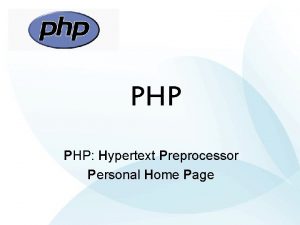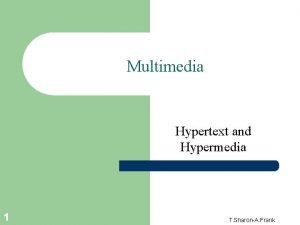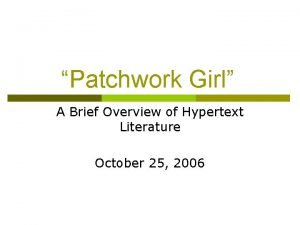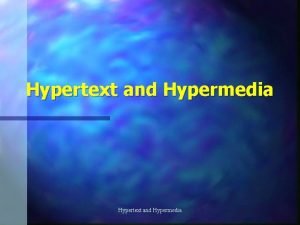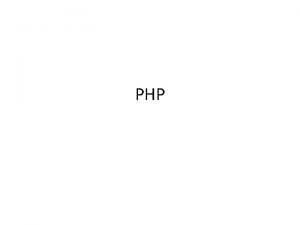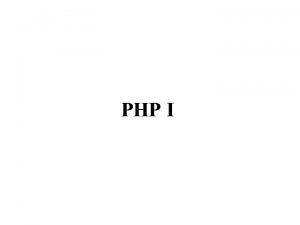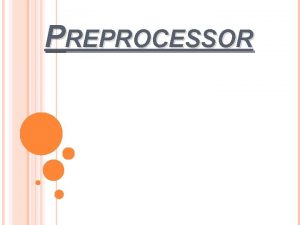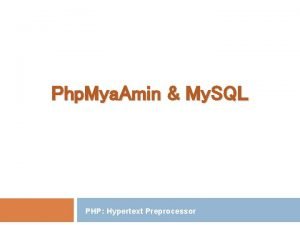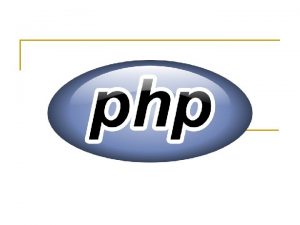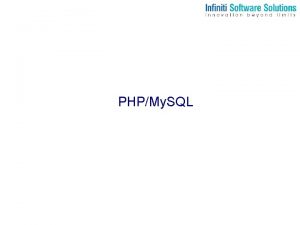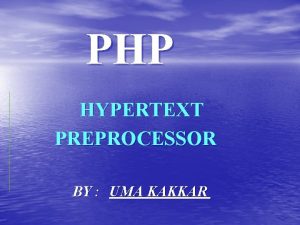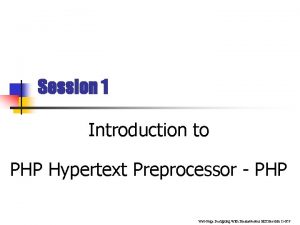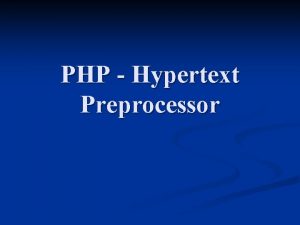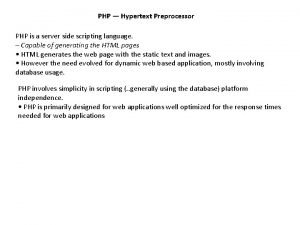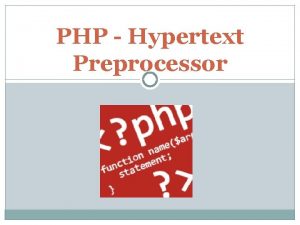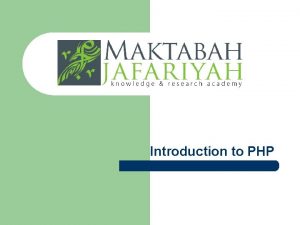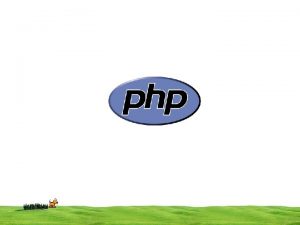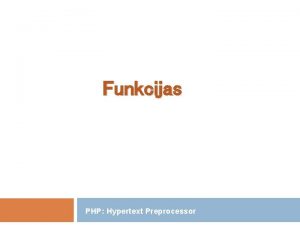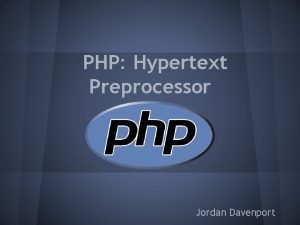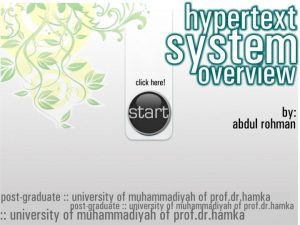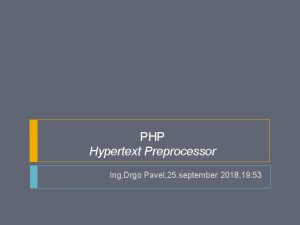PHP PHP STAND FOR HYPERTEXT PREPROCESSOR PHP HISTORY

























- Slides: 25


PHP PHP STAND FOR HYPERTEXT PREPROCESSOR

PHP HISTORY PHP development began in 1994 when Rasmus Lerdorf wrote a series of Common Gateway Interface (CGI) binaries in C which he used to maintain his personal homepage. He extended them to add the ability to work with web forms and to communicate with databases, and called this implementation "Personal Home Page/Forms Interpreter" or PHP/FI.

PHP WHAT IS Common Gateway Interface (CGI)

PHP COMMON GATEWAY INTERFACE (CGI) Common Gateway Interface (CGI) is a standard method used to generate dynamic content on Web pages and Web applications. CGI, when implemented on a Web server, provides an interface between the Web server and programs that generate the Web content. These programs are known as CGI scripts or simply CGIs; they are usually written in a scripting language, but can be written in any programming language.

PHP PHP/FI could be used to build simple, dynamic web applications. RASMUS initially announced the release of PHP/FI as "Personal Home Page Tools (PHP Tools) version 1. 0" publicly to accelerate bug location and improve the code, on the. Usenet discussion on June 8, 1995. A development team began to form and, after months of work and beta testing, officially released PHP/FI 2 in November 1997. Zeev Suraski and Andi Gutmans rewrote the parser in 1997 and formed the base of PHP 3, changing the language's name to the recursive acronym PHP: Hypertext Preprocessor. Afterwards, public testing of PHP 3 began, and the official launch came in June 1998.

At GLANCE PHP HISTORY PHP (PHP: Hypertext Preprocessor) was created by Rasmus Lerdorf in 1994. It was initially developed for HTTP usage logging and server-side form generation in Unix. PHP 2 (1995) transformed the language into a Server-side embedded scripting language. Added database support, file uploads, variables, arrays, recursive functions, conditionals, iteration, regular expressions, etc. PHP 3 (1998) added support for ODBC data sources, multiple platform support, email protocols (SNMP, IMAP), and new parser written by Zeev Suraski and Andi Gutmans. PHP 4 (2000) became an independent component of the web server for added efficiency. The parser was renamed the Zend Engine. Many security features were added. PHP 5 (2004) adds Zend Engine II with object oriented programming, robust XML support using the libxml 2 library, SOAP extension for interoperability with Web Services, SQLite has been bundled with PHP 5 (2014 PHP 5. 4 offers a built-in web server which runs from the Windows, Mac or Linux command line. While it’s not Apache or IIS, it’s fine for simple testing. I suspect many of the better PHP IDEs will implement support shortly.

PHP Suraski and Gutmans then started a new rewrite of PHP's core, producing the Zend Engine in 1999. On May 22, 2000, PHP 4, powered by the Zend Engine 1. 0, was released. On July 13, 2004, PHP 5 was released, powered by the new Zend Engine II. PHP 5 included new features such as improved support for object-oriented programming, the PHP Data Objects (PDO) extension (which defines a lightweight and consistent interface for accessing databases), and numerous performance enhancements. In 2008 PHP 5 became the only stable version under development. PHP is a server scripting language, and a powerful tool for making dynamic and interactive Web pages.

PHP WHAT YOU SOULD ALREADY KNOW ØHTML ØCSS ØJAVASCRIPT

what is php? PHP is stand for "PHP: Hypertext Preprocessor“ PHP is a widely-used, open source scripting language PHP scripts are executed on the server PHP is free to download and use Its totally free on which plateform it is used that’s also free. Ø Its an open source including all thing in php as open source its new named is LAMP(Linux, apache, mysql, php) Ø LAMP Technology All are open source and free of cost. Ø So there is no need to pay for php software. Ø Ø Ø

PHP what is php file? Ø PHP files can contain text, HTML, CSS, Java. Script, and PHP code Ø PHP code are executed on the server, and the result is Ø returned to the browser as plain HTML Ø PHP files have extension ". php"

PHP what can php do? Ø PHP can generate dynamic page content Ø PHP can create, open, read, write, delete, and close files on the server Ø PHP can collect form data Ø PHP can send and receive cookies Ø PHP can add, delete, modify data in your database Ø PHP can be used to control user-access Ø PHP can encrypt data

PHP Why Php? Ø PHP runs on various platforms (Windows, Linux, Unix, Mac OS X, etc. ) Ø PHP is compatible with almost all servers used today (Apache, IIS, etc. ) Ø PHP supports a wide range of databases Ø PHP is free. Download it from the official PHP resource: www. php. net Ø PHP is easy to learn and runs efficiently on the server side

PHP Application in php 1. 2. 3. 4. Facebook Olx Snapdeal most of ecommerce site are developed in php

PHP what is cms CMS is Content Management System. This is a complete functionality that normally we only change the html design (called templates) and install as website. These CMS share complete and ready for use. They are written following a certain logic that can be changed or add new features. This type of applications are fine for small and medium web sites or web applications that the customer’s needs are close to what the CMS suggest as features. In additional ot these CMSs we have some additional features or as we call it Plugins. These plugins are making the CMS very flexible and they apply to many customer needs. One CMS with plugins are covering if not all needs at least most of them. Example : Drupal, Joomla, wordpress

PHP HEADER COMMON CONTENT FOOTER COMMON

PHP

PHP what is framework Framework in the programming area is a group of classes and methods (functions) most commonly. They are used for easier, faster and better quality writing/creating application like web sites or web

PHP php frameworks Code. Igniter is an Application Development Framework - a toolkit - for people who build web sites using PHP. Its goal is to enable you to develop projects much faster than you could if you were writing code from scratch, by providing a rich set of libraries for commonly needed tasks, as well as a simple interface and logical structure to access these libraries. Code. Igniter lets you creatively focus on your project by minimizing the amount of code needed for a given task.

PHP Cakephp Cake. PHP is a rapid development framework for PHP which uses commonly known design patterns like Active. Record, Association Data Mapping, Front Controller and MVC. Our primary goal is to provide a structured framework that enables PHP users at all levels to rapidly develop robust web applications, without any loss to flexibility.

PHP Symfony is a web application framework for PHP 5 projects. It aims to speed up the creation and maintenance of web applications, and to replace the repetitive coding tasks by power, control and pleasure. The very small number of prerequisites make symfony easy to install on any configuration; you just need Unix or Windows with a web server and PHP 5 installed. It is compatible with almost every database system. In addition, it has a very small overhead, so the benefits of the framework don’t come at the cost of an increase of hosting costs.

PHP zend Extending the art & spirit of PHP, Zend Framework is based on simplicity, object-oriented best practices, corporate friendly licensing, and a rigorously tested agile codebase. Zend Framework is focused on building more secure, reliable, and modern Web 2. 0 applications & web services, and consuming widely available APIs from leading vendors like Google, Amazon, Yahoo!, Flickr, as well as API providers and cataloguers like Strike. Iron and Programmable. Web.

PHP Application Developers are using frameworks for very custom applications where customer needs cannot be covert with CMS. Also these frameworks are used for very huge applications for better service. Frameworks are Symfony, Zend, Code. Igniter, PHP Cake and many others.

PHP <html> <head> <title>Example</title> </head> <body> <? php echo "Hi, I'm a PHP script!"; ? > </body> </html>

PHP Thank you
 Pre hypertext processor
Pre hypertext processor T.php
T.php What is preprocessor in php
What is preprocessor in php Php hypertext preprocessor
Php hypertext preprocessor Php hypertext preprocessor
Php hypertext preprocessor Php stands for hypertext pre-processor. *
Php stands for hypertext pre-processor. * What is php stands for
What is php stands for Hypertext processor
Hypertext processor Nasm local labels
Nasm local labels Nasm macros
Nasm macros Nasm loop
Nasm loop Snort plugins
Snort plugins Aif ago and anop
Aif ago and anop Preprocessor in compiler construction
Preprocessor in compiler construction Html preprocessor
Html preprocessor Nasm jump table
Nasm jump table Stand up for jesus
Stand up for jesus Hello hello everyone i nanny shine
Hello hello everyone i nanny shine Personal hypertext processor
Personal hypertext processor Hypermedia vs hypertext
Hypermedia vs hypertext Hypermedia vs hypertext
Hypermedia vs hypertext Example of print media hypertext
Example of print media hypertext Digi fiction examples in the philippines
Digi fiction examples in the philippines Patchwork girl hypertext
Patchwork girl hypertext Qtextarea
Qtextarea Hypertext and hypermedia
Hypertext and hypermedia
